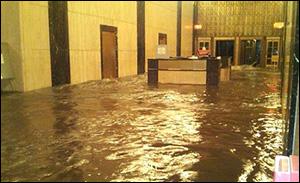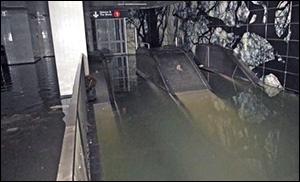By Pam Martens: November 1, 2012

During Hurricane Sandy, Photo of Lobby of 140 West Street in Lower Manhattan, Released by New York State Governor Andrew Cuomo
Despite what the paper of record would have you believe, Hurricane Sandy was not about killer trees. Hurricane Sandy, like Hurricane Katrina, was about killer water.
The New York Times put it this way on Tuesday, before the death toll had climbed even higher: “There were 22 deaths reported in New York City, where the toll was heaviest, and 5 more fatalities elsewhere in the state. Most of all, it was the trees. Uprooted or cracked by the furious winds, they became weapons that flattened cars, houses and pedestrians.”
Here’s the way those last two sentences should have read: “Most of all, it was the wall of water. Giant storm surges rushing over the sea walls, turning roads into instant rivers replete with white caps that pulled two toddlers from their mother’s arms and sent many more to a watery grave in their basements.”
As of this morning, only 3 people in New York City are reported to have died as a result of falling trees, or 10 percent of the now reported 34 deaths in New York City. A staggering 64 percent of the storm-related deaths in New York City resulted directly from drowning or as a result of an unprecedented wall of water hitting the individual directly or while they were inside their homes.
On Staten Island, where a giant storm surge turned homes into death traps, details on five more deaths were released, in addition to those we reported yesterday: an 89-year-old woman, Ella Norris, was found drowned in her home at 728 Buel Ave.; Anastasia Rispoli, 73, was found dead in her home; Andrew Semarco, 61, was found dead in his home on Mills Avenue; Leonard Montalto, 53, was pronounced dead in his home at Fox Beach Avenue; James Rossi, 85, was found in deep water in his backyard and pronounced dead.
Two more drownings were discovered in the Rockaways: Rick Gold, 67, in a submerged basement on Beach 133rd St. and Nancy Sorenson, 50, on Beach 124th St.
An 87-year-old man, Hugo Senpo, was pronounced dead in his flooded Coney Island home.
This was New York City’s Katrina wakeup call and based on New York State Governor Andrew Cuomo’s noontime press conference yesterday with Senator Charles Schumer – they both get it. They get that one of the most important and largest cities in the United States is flirting with disaster along with putting the lives of 8 million residents on the line by ignoring its antiquated infrastructure and its non-reality based view of what climate change means to a densely populated sliver of land surrounded by water. Mayor Bloomberg, on the other hand, has not said a word about the drowning deaths in his many press conferences and put air quotes around the phrase “climate change” as he addressed reporters. The New York Times’ inability to see the forest for the trees adds to the problem.
This is what Mayor Bloomberg had to say about the loss of life at his press conference:
“I think that the best thing we can do for those that we lost is to make sure that we do everything we can to next time we have a big storm do an even better job of protecting people, giving them more warning. Maybe people will find different ways to communicate with them. Any loss of life is tragic – sadly nature is dangerous and these things occur, but we’re going to do everything we can do prevent tragedies in the future, and I think the best we can do for those who did die is to make sure the city recovers and comes out of this and builds a better life for those that the deceased left behind. That’s the best thing we can do, and in many senses it’s the only thing we can do.”
Making sure the city recovers is not the same thing as making sure the city redesigns itself. New York City needs to implement serious, long term solutions to rising seas such as strategically placed storm walls, automatically triggered tunnel pumps, elevated subway entrances and a host of other carefully researched ideas — many of which are gathering dust in the city’s own archives.


